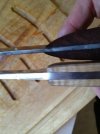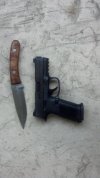- Joined
- Feb 23, 1999
- Messages
- 4,855
Yangdu sent me out knife #4 from Anils offerings in this thread.
I like small knives with offset blades. The offset serves as a guard to prevent a hand from slipping up onto a sharp edge, and it also permits cutting against a board or a log without the hand getting in the way. Many kitchen knives have this feature. Ive never discussed my preference with Yangdu. Yet she sent me the one knife of all the 4 that had the most pronounced offset. I wonder how she does that.
I gathered up some of the other knives I use that have offset handles. In the picture below you will see Anils knife on the bottom. Next are 2 knives forged from files by members of the Larios family in Sayula, Mexico a number of years ago. The one with the red handle has seen years of use in my kitchen, while the slightly thicker one with the maple handle gets field use. On top is a Boker with a blade of 440C that I use for saltwater fishing. It has slit the gills of many a fish, and done its share of gutting and cutting bait too.

Also for comparison purposes is a new Carvel Hall cleaver I picked up at Goodwill for $3. It was made in Japan, and has the word CLEVER deeply stamped into the wood handle. Its about the same size and weight as the Anil knife. The cleaver blade, while wider, is also thinner than Anils knife. For chopping weight, they have a similar feel. The Anil knife could address cleaver tasks. While perhaps not as efficient as the cleaver in its specialized role, it will do.


A few minutes after this picture was taken I used the Anil knife to whittle the misspelling off of the cleaver handle.
The Anil knife snaps solidly into its sheath, and is well retained. Here is a shot of all the sheaths lined up. Anils sheath is one of the smallest, although his knife is the largest. It is a nice carrying package.

The knife had a good edge on it right out of the box, so I used it as it came for a little vegetable cutting. On onions, my first try sprung the onions apart due to the thickness of the blade. After that, I held both sides of the onions and it wasnt a problem. When comparing ease of cutting, the thin bladed Larios was the easiest, but all the others including Anil's were about the same. All were quite serviceable for meal preparation.






Over the next few days I used it for meat cutting and kitchen chores, and even took it out to the deck to harvest some of my heritage multiplier onions. It cut down the large stalks as seen in this picture. Note the patina naturally developing on the blade.

These onions produce little bulbs on the top of the stalks, which can be planted. I used the Anil knife like a trowel to help me plant a number of the bulbs. Rough work for a knife, but I felt bad just giving this big thick knife sissy work.
It worked fine as a trowel, and a couple of strokes on a sharpmaker brought the edge back even better than before. The edge holding is fine. A few days later I gave the knife a couple of swipes over the work-sharp with a coarse grit belt, just to see how it would do. It produced a nice toothy edge that was excellent for cutting meat.
I read how Karda had lovingly spent some quality time with sandpaper to bring out the beauty of the handle. I did notice some angular edges on the wood handle of mine, so I went to get some coarse sandpaper. 2 minutes later I had knocked off the angular edges. (I think the knives pray they will go to Kardas place rather than mine!) Then I put on a bit of food-grade oil I use for my butcher block. The handle will evolve. I expect in a few years it will look similar to the maple handled Larios in the photos above.
I no longer heat with wood, so the need to split kindling is no longer present. Ive batted enough knives through wood to know that this stout blade profile would have no problem with chopping, splitting and battoning.
Anil has produced a fine, field grade knife. A good outfitter would be proud to offer this to his customers, knowing that it could be depended on as a solid, reliable knife, capable of not only kitchen type chores, but also chopping, battoning, or digging should the need arise.
I like small knives with offset blades. The offset serves as a guard to prevent a hand from slipping up onto a sharp edge, and it also permits cutting against a board or a log without the hand getting in the way. Many kitchen knives have this feature. Ive never discussed my preference with Yangdu. Yet she sent me the one knife of all the 4 that had the most pronounced offset. I wonder how she does that.
I gathered up some of the other knives I use that have offset handles. In the picture below you will see Anils knife on the bottom. Next are 2 knives forged from files by members of the Larios family in Sayula, Mexico a number of years ago. The one with the red handle has seen years of use in my kitchen, while the slightly thicker one with the maple handle gets field use. On top is a Boker with a blade of 440C that I use for saltwater fishing. It has slit the gills of many a fish, and done its share of gutting and cutting bait too.

Also for comparison purposes is a new Carvel Hall cleaver I picked up at Goodwill for $3. It was made in Japan, and has the word CLEVER deeply stamped into the wood handle. Its about the same size and weight as the Anil knife. The cleaver blade, while wider, is also thinner than Anils knife. For chopping weight, they have a similar feel. The Anil knife could address cleaver tasks. While perhaps not as efficient as the cleaver in its specialized role, it will do.


A few minutes after this picture was taken I used the Anil knife to whittle the misspelling off of the cleaver handle.
The Anil knife snaps solidly into its sheath, and is well retained. Here is a shot of all the sheaths lined up. Anils sheath is one of the smallest, although his knife is the largest. It is a nice carrying package.

The knife had a good edge on it right out of the box, so I used it as it came for a little vegetable cutting. On onions, my first try sprung the onions apart due to the thickness of the blade. After that, I held both sides of the onions and it wasnt a problem. When comparing ease of cutting, the thin bladed Larios was the easiest, but all the others including Anil's were about the same. All were quite serviceable for meal preparation.






Over the next few days I used it for meat cutting and kitchen chores, and even took it out to the deck to harvest some of my heritage multiplier onions. It cut down the large stalks as seen in this picture. Note the patina naturally developing on the blade.

These onions produce little bulbs on the top of the stalks, which can be planted. I used the Anil knife like a trowel to help me plant a number of the bulbs. Rough work for a knife, but I felt bad just giving this big thick knife sissy work.
It worked fine as a trowel, and a couple of strokes on a sharpmaker brought the edge back even better than before. The edge holding is fine. A few days later I gave the knife a couple of swipes over the work-sharp with a coarse grit belt, just to see how it would do. It produced a nice toothy edge that was excellent for cutting meat.
I read how Karda had lovingly spent some quality time with sandpaper to bring out the beauty of the handle. I did notice some angular edges on the wood handle of mine, so I went to get some coarse sandpaper. 2 minutes later I had knocked off the angular edges. (I think the knives pray they will go to Kardas place rather than mine!) Then I put on a bit of food-grade oil I use for my butcher block. The handle will evolve. I expect in a few years it will look similar to the maple handled Larios in the photos above.
I no longer heat with wood, so the need to split kindling is no longer present. Ive batted enough knives through wood to know that this stout blade profile would have no problem with chopping, splitting and battoning.
Anil has produced a fine, field grade knife. A good outfitter would be proud to offer this to his customers, knowing that it could be depended on as a solid, reliable knife, capable of not only kitchen type chores, but also chopping, battoning, or digging should the need arise.


